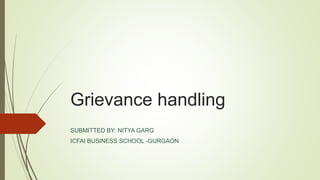
Grievance handling
- 1. Grievance handling SUBMITTED BY: NITYA GARG ICFAI BUSINESS SCHOOL -GURGAON
- 2. What are GREVIANCES? An official statement of a complaint over something believed to be wrong or unfair. A grievance is any dissatisfaction or feeling of injustice in connection with one’s employment situation that is brought to the attention of the management
- 3. W’s of Grievance Handling WHO is involved WHEN did it happen WHERE did it happen WHAT happened (EXACTLY) WHY is it grieve-able WHEN must the grievance be filed WHAT are the deadline dates WHAT must be done
- 4. Types of Grievance: General v/s Individual General The General Grievance is a grievance that affects a group of employees. Examples of general grievances would be a wage cut or a retrenchment exercise that could involve several employees or the entire workforce. Individual The Individual Grievance is a grievance affecting one employee and requires a one- to-one approach, with or without the Trade Union Representative (TUR), depending whether the organisation is unionised.
- 5. Grievance must fall under the following category : Amenities Compensation Conditions of work Continuity of service Disciplinary action Fines Leave Medical benefits Nature of job Payments Promotions Safety environment Super Annuation Supersession Transfers Victimization
- 6. Important steps in grievance handling procedure Accepting the grievance and acknowledging it. Carefully listening the problem Understanding the redefining the problem to ensure that both the parties are at the same level of understanding. Gathering the information – all facts and figures. Offering the best solution. Follow up.
- 7. Grievance Identification Techniques Observations Grip Boxes Exit Interview Open Door Policy
- 8. Explanations: Grievance Identification Techniques 1. OBSERVATION Knowledge of human behavior is requisite quality of good manager. From the changed behavior of any employee , he should snuff the causes of grievances, without its knowledge to the employee. 2. GRIP BOXES The suggestion boxes, for instance are placed at easily accessible spots to most employees in the organization. The employees can file anonymous complaints about their dissatisfaction in these boxes.
- 9. Cont. 3. OPEN DOOR POLICY Most of the organizations still don’t practice this but open door policy demands that the employees, even at the lowest rank, should have easy access to the Chief Executive to get his grievances redressed. 4. EXIT INTERVIEW These interviews are conducted to know the reasons for leaving the job. Properly conducted exit interviews can provide significant information about the strengths and weaknesses of the organization and can pave way for further improvements.
- 10. Effects of Grievance: Grievances, if not identified and redressed, may adversely affect workers, managers, and the organization. The effects are the following: 1. On the production: a. Low quality of production b. Low productivity c. Increase in the wastage of material, spoilage/leakage of machinery d. Increase in the cost of production per unit
- 11. Cont. 2. On the employees: a. Increase in the rate of absenteeism and turnover b. Reduction in the level of commitment, sincerity and punctuality c. Increase in the incidence of accidents d. Reduction in the level of employee morale. 3. On the managers: a. Strained superior-subordinate relations. b. Increase in the degree of supervision and control. c. Increase in indiscipline cases d. Increase in unrest and thereby machinery to maintain industrial peace
- 12. Benefits of Grievance Handling: Enables the management to know the pulse of its employees. Provides a channel to the aggrieved to express their grievances. Gives an assurance to the employees about the existence of a mechanism for the prompt redressal of their grievance. It encourages employees to raise concerns without fear of reprisal. It provides a fair & speedy means of dealing of grievances. It prevents minor disagreements developing into more serious disputes. It saves employer’s time & money as solutions are found for workplace problems. It helps build in organizational climate based on openness and trust.
- 13. Reference: Book : Human Recourse Management by: Sunaina Sardana. Google: http://www.yourarticlelibrary.com/human- resources/grievance-handling-definition-features-causes-and- effects/32387/
- 14. THANK YOU
